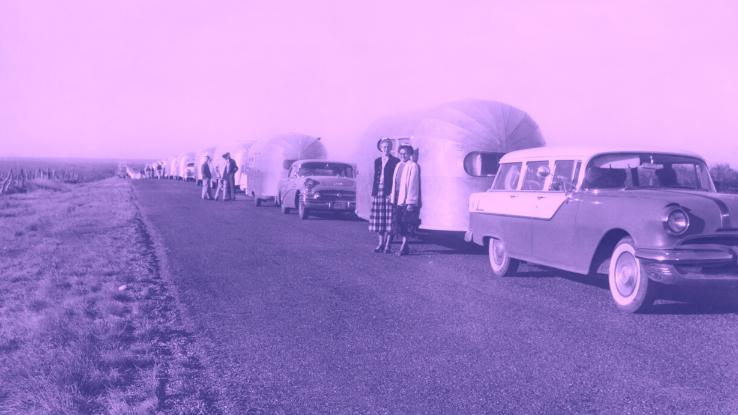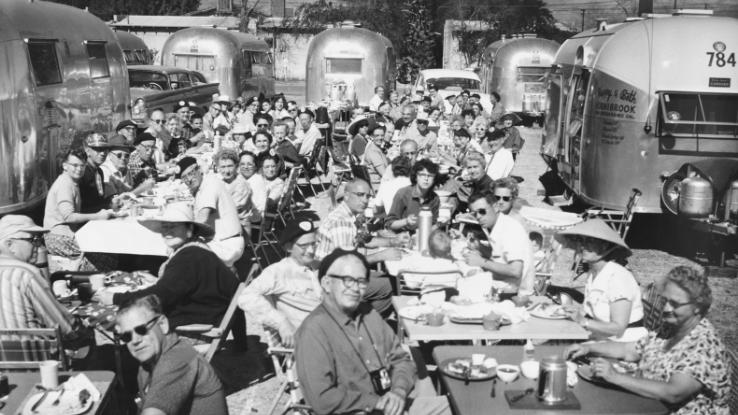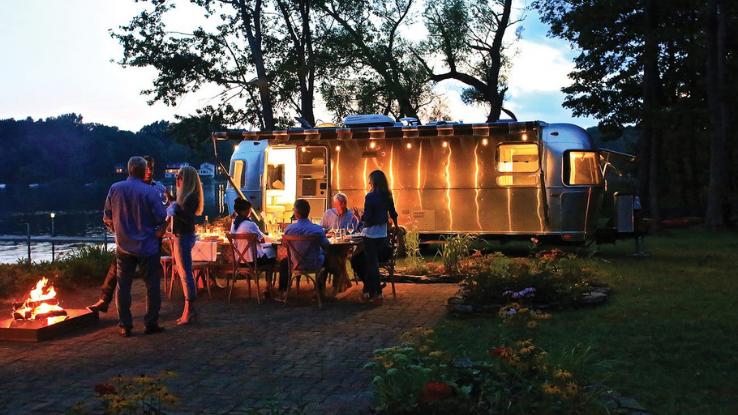Pre-owned Airstreams Are Back in Style: The Fascinating History of This American Classic

There’s no doubt that you’ve seen an Airstream on the road. At one time, they were as popular as their sleek design is unique. In fact, the “silver bullet” has been synonymous with camping and road trips for almost 100 years. In a sense, these legendary trailers and touring coaches have become much more than just another RV or trailer. We’re hard-pressed to think of another vehicle with such a cultural impact — save maybe the VW Beetle.
After all, for many folks across the country, they’ve become a way of life — and a symbol of Americana. Now, the Airstream’s ties to adventure has inspired travelers all over the world. And that’s just how Airstream founder, Wally Byam, would’ve wanted it. Back when he came up with the idea, Byam wanted to people to change the way they get outside and see the world. With the Airstream, which has recently come back in vogue, Byam did just that and more, creating something of an American icon in the process.
How the Airstream Came to Be
Wally Byam and his first wife, Marion, loved to go camping. But, like a lot of people, Marion didn’t enjoy sleeping on the ground or in a traditional tent. To salvage Marion’s love of camping, Wally built his own tent-style contraption that sat on the top of their Model T in 1929. It worked for the most part, but it wasn’t waterproof. To make matters worse, setting it up was an incredibly time-consuming task. So, Wally went back to the drawing board.

At that drawing board, Wally swapped out the tent for a teardrop-shaped shelter, even going so far as to include a stove and ice chest in his design. The new contraption caught the eyes of several fellow travelers while Wally and Marion were out on the road, which encouraged him to take his hobby to the next level. By 1931, the first Airstream factory opened in California. With fewer than 50 other manufacturers building a similar trailer type, the Airstream was filling a rather significant void.
Over the next five years, there’s was a real demand for the trailer. But, rather unexpectedly, alongside that demand, a whole new lifestyle emerged. By 1937 there were almost 400 other manufacturers vying for the love and loyalty of customers around the country. Unfortunately, both the Great Depression and World War II changed all of that; Wally closed his doors to aid the war effort, with himself and other mechanics finding work in aircraft factories. Still, this experience played a pivotal role in deciding Airstream’s future design.
The First Major Redesign in 30 Years
Although Wally stepped down from Airstream in the 1960s due to health reasons, 1969 saw the now-iconic trailer undergo its first major overhaul in over 30 years. By expanding manufacturing capacity, the company was able to add the first-ever hot water system into the trailer; implement external trailer hookups; and create the first-ever self-contained travel trailer that had an external power source.
Additionally, structural changes were implemented to make the trailer sturdier, and the interior was refashioned to give it a more modern feel. (And, of course, to accommodate some of those modern amenities.) In the end, these redesigns transformed the Airstream into that instantly recognizable silver bullet we have come to know and love. But Airstream’s innovations weren’t contained to travel and road-tripping.
That same year, NASA contracted Airstream to develop a mobile quarantine facility, which would be used in a precautionary manner. The idea? Well, NASA worried that the astronauts tasked with visiting the moon might bring some diseases back with them, so officials wanted Neil Armstrong, Buzz Aldrin and Michael Collins to quarantine inside a few Airstreams when they returned to Earth.

Carving Out Its Place in Americana
The next 20 years saw Airstream undergo some leadership changes. Moreover, the main manufacturing facility was moved to the Midwest, and the company pushed to diversify its overall offerings. In 1974, with the idea of expanding from a single-revenue stream, this new leadership introduced the Argosy motorhome. Although this motorhome was discontinued just five years later, it set the stage for future innovation, including the Classic motorhome, the Interstate touring coach, and the Land Yacht motorhome.
Without a doubt, the trailers had solidified themselves as part of American culture. In fact, a 1987 issue of Money magazine listed the Airstream alongside titans like Heinz and Coca-Cola on their list of “99 Things That, Yes, Americans Make Best.” However, this didn’t stop the company from continuing to pursue an increasingly innovative path.
During the 1990s, Airstream pushed to attract a new generation of travelers. Part of this move saw the company introducing a brand-new, remodeled version of the Safari trailer, which had originally hit markets in the ’50s. More affordable and lighter than the original, it could be towed behind almost any type of vehicle with ease, which made it all the more accessible. Soon enough, almost half of all Airstreams sold were the new Safari model. Clearly, the company’s iconic look — and Wally’s vision — continues to resonate.
Here’s Why Airstreams Are Back in Style
It took 30 years for Airstreams to receive their first big overhaul — and it took almost another three decades for the next major shift in 1994. With more width and a redesigned structure and shape, the Airstream of the ’90s was more comfortable and spacious, but it maintained both its trusted performance and classic looks, both of which had made it such a popular trailer to begin with. That one-of-a-kind (and immediately recognizable) silver bullet design has no doubt contributed to the longevity of the trailers. According to Airstream “approximately 70 percent of the Airstream travel trailers ever built are still on the road,” which is incredibly impressive.

Still, even though these trailers were built to last, sales of new Airstreams continue to rise for folks who can’t get their hands on pre-owned airstreams. It’s clear that many folks are nostalgic for this piece of American-made history, but Airstreams have also come to symbolize adventure — and being on the open road. Of course, Airstreams also have a place in the world of stationary lodgings, from being used as unique, nature-bound Airbnbs to playing a role in the resurgence of “glamping.” (You know, glamorous, tent-free and amenity-filled camping — the way Marion would’ve wanted it.) Not to mention, the COVID-19 pandemic has played a big role in this resurgence as people are finding inventive ways to travel safely, get outside, and connect with loved ones.
Although the pandemic forced the 90-year-old company to shut down manufacturing for several months, it’s clear that travelers were more comfortable staying in trailers and driving across than country than staying in hotels or flying. “It’s hard to imagine a product that checks as many boxes as an RV for the emerging pandemic lifestyle,” Airstream CEO Bob Wheeler said in an interview with Business Insider.
According to Wheeler, Airstream broke its all-time sales record for any month dating back to 1980 (when the company’s record-keeping started) in May of 2020. Despite being almost unable to keep up with the incredible demand, Airstream is still looking to innovate. For example, they’ve struck a partnership with AT&T to ensure newer models are equipped with WiFi for all the remote workers out there. So, the real question might not be about whether or not Airstreams are back in style. Instead, we can’t help but wonder if Airstreams were ever out of style?





